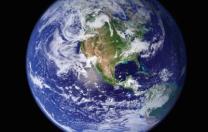Three days before Harvard’s launch of the Center for Geographic Analysis, National Geographic News released the results of a survey of geographic literacy in young adults in the United States. Its findings were not startling. “Take Iraq, for example,” read the report. “Despite nearly constant news coverage since the war there began in 2003, 63 percent of Americans aged 18 to 24 failed to correctly locate the country on a map of the Middle East. Seventy percent could not find Iran or Israel. Nine in ten couldn’t find Afghan istan on a map of Asia.” (How about you, reader?) David Rutherford, a specialist in geography education at the National Geographic Society in Washington, was quoted as saying, “Young Americans just don’t seem to have much interest in the world outside of the United States.” That may change, for an economic reason if none other.
In 1947, when Marland P. Billings, professor of geology at Harvard, launched an attack on its geography program, he touched off what the Crimson called “an academic war.” The decisive battle came a year later, when Provost Paul Buck and President James B. Conant axed geography, with the president declaring that “geography is not a university subject.” The late urban geographer Jean Gottmann (who coined the term megalopolis) in 1982 characterized the defeat as “a terrible blow…to American geography” and one from which “it has never completely recovered.”
Geographer Neil Smith wrote an exhaustive analysis of the war for the Annals of the Association of American Geographers in 1987, when he was teaching at Rutgers University. “Oral accounts of the Harvard affair have centered almost exclusively on the character and actions of several key individuals. It has been widely asserted that Derwent Whittlesey, who led geography at Harvard in the 1930s and 1940s, was gay and that this was the pivotal issue in the elimination of the geography department,” wrote Smith. “Alexander Hamilton Rice, a scoundrel by various accounts, who funded and headed the university’s Institute for Geographical Exploration, has also been widely implicated” in its demise. Smith wrote to lift “a heavy surrounding fog of mythology” from the matter and to suggest the true reasons why the war was lost.
Geography had been weak at Harvard particularly, although perhaps one prominent critic went too far when he called the program an intellectual kindergarten and the Ph.D.s it granted worthless. More importantly, Smith concluded, the field generally had weakened itself through “the ambiguity of its own self-conception.” At Harvard, as elsewhere, geography was taught at first as part of geology, with the emphasis on hard-science topics such as geomorphology. But the human side of geography emerged, and parts of the discipline began to be seen as soft—as social science. A Harvard committee appointed in 1949 to reconsider whether dropping geography had been a good thing “was perplexed,” wrote Smith, “by its inability to extract a clear definition of the subject, to grasp the substance of geography, or to determine its boundaries with other disciplines. To the end the committee saw the field as hopelessly amorphous.” Moreover, and perhaps most important in the fight, Buck and Co nant wanted to save money. One fallen soldier opined, “Conant thinks that he is captain of a sinking ship [financially] and he is prepared to jettison anything. Geography was the first good opportunity.”
Geography would rise from this wreckage. The quantitative method of geographical research began to gain ground after World War II, and increasingly capable computers let researchers manipulate and display burgeoning amounts of new data. In the Harvard Graduate School of Design’s Laboratory for Computer Graphics and Spatial Analysis, founded by Howard T. Fisher, geographers, cartographers, artists, mathematicians, and computer savants began in 1965 to invent a way to make map displays on a computer. Jack Danger mond, president of Environmental Systems Research In sti tute, worked there in his student days. “We made maps,” he recalls, “on very funny output devices like line printers, which would do alphanumeric overprinting of characters in order to create gray tones for thematic displays of such things as population density, soil composition, and vegetation.” Nicholas R. Chrisman, now professor of geomatics sciences at the Université Laval in Quebec City, worked in this frontier lab from 1972 to 1982. He believes that the place was key to the development of GIS and spatial analysis, as he writes in his new book, Charting the Unknown: How Computer Mapping at Harvard Became GIS (ESRI Press), which comes with a CD containing three short films, video interviews, and more.
Key, too, were the swelling power of computers and their shrinking price. “Ten years ago,” says Wendy Guan, director of GIS (geographic information system) research services at the Center for Geographic Analysis, “just about any GIS would require a much-heavier-than-average workstation to operate on. Today, just about any decent PC can run GIS software with reasonable speed. Some even runs on cell phones.”
“Today, as in the mid-20th century, the academic discipline of geography appears to be under threat” at locales as disparate as the United Kingdom and India, wrote Nigel Waters last year in “What Can GIS Do to Save Geography?” on geoplace.com. He sees the discipline still “hopelessly divided between its physical and human branches.” But the professor of geography at the Uni versity of Calgary hears this gong of hope: “GIS is recognized as providing academic geography with an essential requirement for its survival: a marketable skill.”
“Geotech, nanotech, and biotech are the fastest growing fields in technology,” says historian Peter Bol, director of the Center for Geographic Analysis. “The U.S. government has undertaken massive hiring of people with GIS expertise. Central Intelligence Agency staff told me they had been ordered to double their geospatial-analysis capabilities within a year.”
Waters recounts that veteran Foreign Service officer Carleton S. Coon Jr., at the fiftieth reunion of his Harvard class of 1948, offered what he called “a single pearl of wisdom” at a symposium on foreign policy: “Reinstitute geography at Harvard!”








